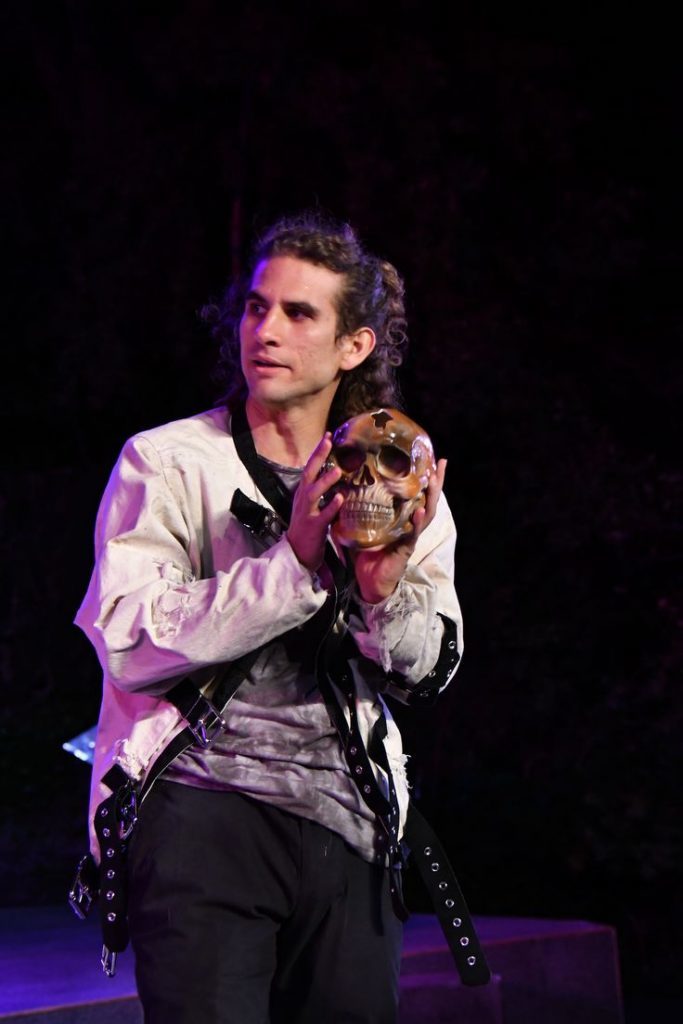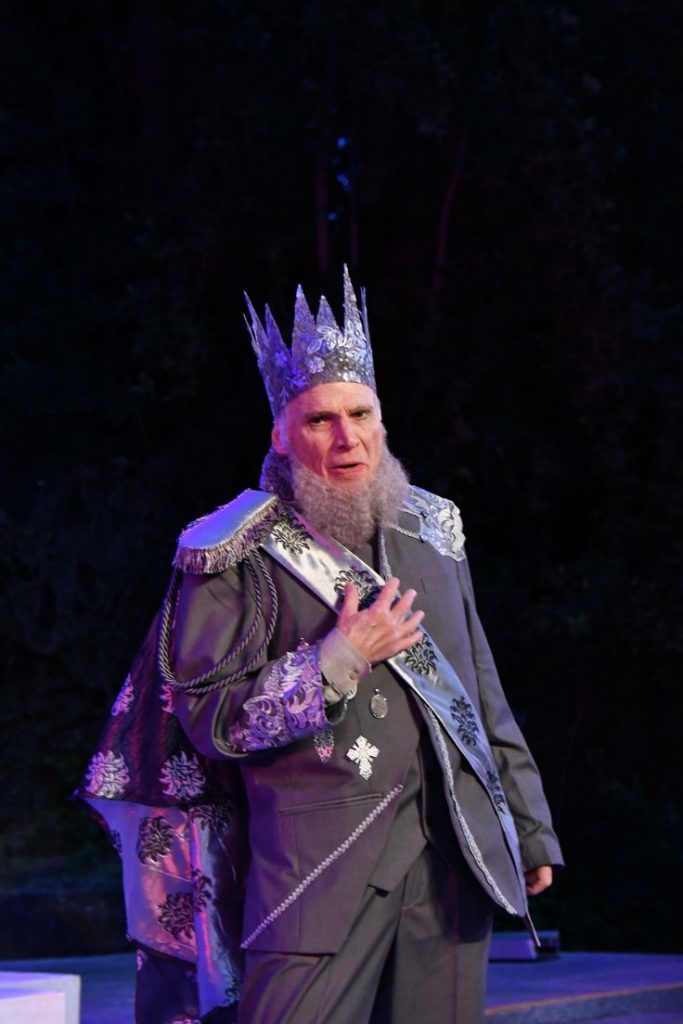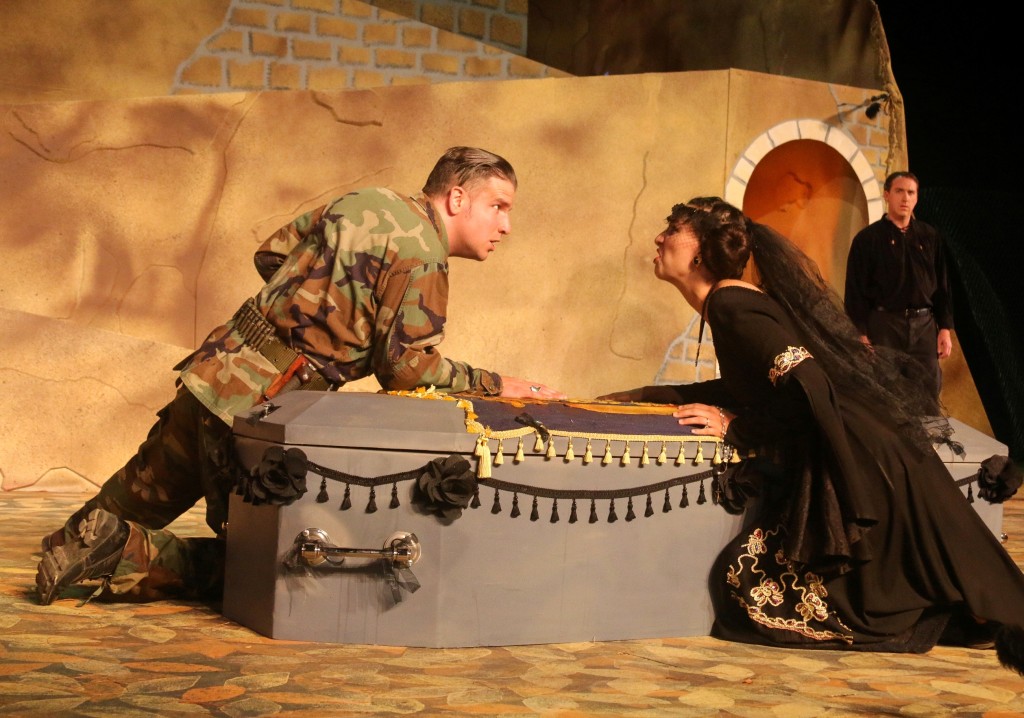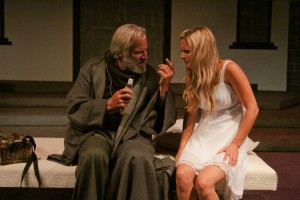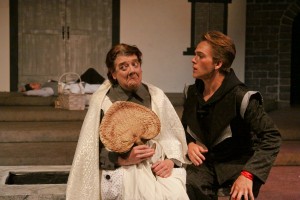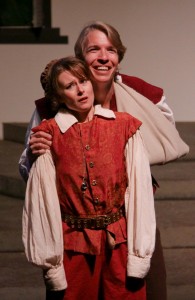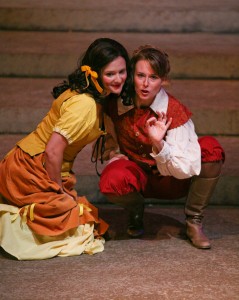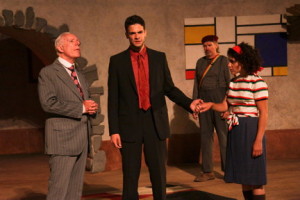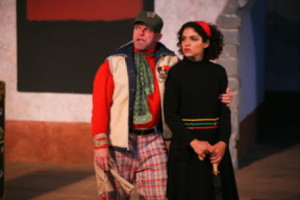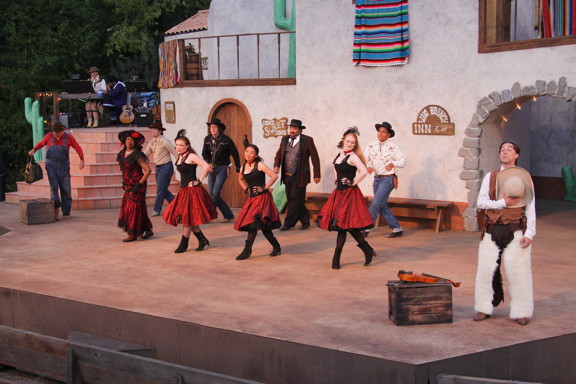An Epic PERICLES at Marin Shakespeare
July 16, 2018 § Leave a Comment
Pericles is generally held to be minor Shakespeare. It was not included in the First Folio, has no reliable text, and was (according to almost all reputable scholars, who credit co-author George Wilkins) only partially written by the Bard. You never read it in school, and you only rarely get to see it. That is a pity, because – with some competent dramaturgy – it works wonderfully well in the theatre. Exhibit A is a delightfully emotional/entertaining production at Marin Shakespeare directed by Lesley Schisgall Currier and starring Dameion Brown in the title role.

Dameion Brown playing Pericles. All photos by Jay Yamada, courtesy of Marin Shakespeare.
Darkest before the Dawn
Pericles is one of the late plays, collectively labeled the Romances, which are generically tragi-comedies. (The others are The Tempest, The Winter’s Tale and Cymbeline.) These plays veer into the darkest of tragic places including the dissolution of the protagonist’s sanity and the apparent deaths of all he holds dear before reversing course and miraculously ending happily. If you get the tone wrong, they can seem manipulative and melodramatic, but if you get it right – and Marin Shakes gets it exactly right – they are indescribably moving. Currier finds the perfect balance of humor, sentiment and mythos to unleash the play’s power.
The play is too stuffed with incident to even attempt a plot summary, but this abundance of adventure, misfortune and eventual resolution is part of what makes it so alluring in the theatre. The action barely takes time to pause as Pericles’ epic journey races from one incident to the next, over decades and continents.
Double, Double…
The production uses a speaking ensemble of 10, many doubling and tripling roles in virtuosic turns. There is a not a weak link to be found, but Kathryn Smith-McGlynn is especially radiant as Thaisa and brilliantly hysterical as her polar opposite, the Bawd.

Kathryn Smith-McGlynn as the Bawd
Elena Wright perfectly sets the tone of the night as a petulant daughter to Antiochus, and is later stunningly commanding as the doctor, Cerimon.
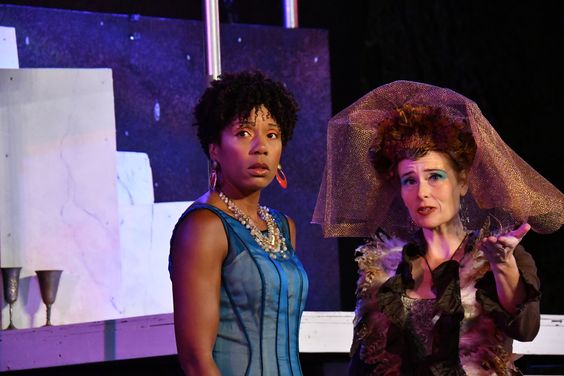
Smith-McGlynn as Thaisa and Elena Wright as Cerimon
It is hard to image any actor finding greater range in roles than the exceptional Rod Gnapp does with the heroic and noble retainer Helicanus contrasted with the relentlessly randy jack-of-all-trades in the brothel, Boult.
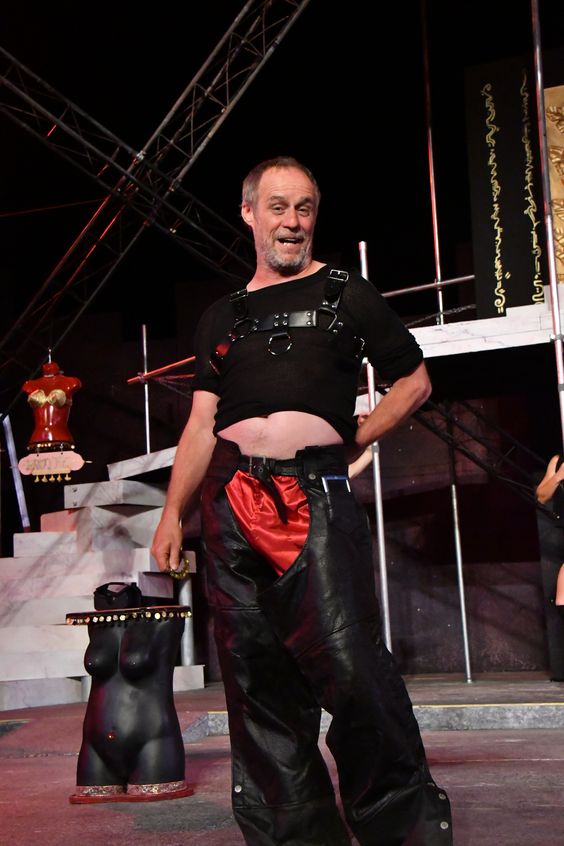
Rod Gnapp as Boult
The entire production is moved briskly along by Diane Wasnak in the role of the narrator, Gower. This is a difficult, and often thankless, role, but she handled it with such clarity and precision that I looked forward to her every appearance.

Diane Wasnak as Gower
At the heart of the production is the relationship between Pericles and the daughter he gave up in infancy and believes to have died in her teens before they could be reunited. The daughter, Marina, is beautifully played by Eliza Boivin. Brown is powerfully emotional all night long, but at his best in the extraordinary scene he shares with her near the end of the play.

Eliza Boivin as Marina with Dameion Brown as Pericles.
Brown is a phenomenon all his own. A former inmate at Salano State Prison, he was discovered and trained by director Currier in their Shakespeare-in-prisons program. Upon his release, he made his professional debut as Othello for Marin Shakespeare, winning a number of best actor awards in the Bay Area. Knowing this history, it is hard not to see the emotional depth in his performance as a man who believes he has lost everything only to find redemption and second chances after decades of misfortune. If you love Shakespeare, you’d be crazy to miss this performance, even if it had no other virtues than the realization of this beautiful scene. Of course, it does have other virtues, and lots of them!
This company is not spectacle oriented but Jackson Currier’s set design is suggestive of the cosmic scale of the epic play. Merissa Mann, the costume designer, has the unenviable task of costuming this play that requires literally hundreds of costumes. Those most central to the production are wonderfully executed but, unfortunately, in the production’s only real downside, many of the costumes for minor characters and extras seem chosen for their ability to be changed quickly and neither look good nor fit. Joel Eis’ props, by contrast are comically perfect.

The cast on Jackson Currier’s set.
More Information
Pericles – July 14 – August 5, 2018, By William Shakespeare / Directed by Lesley Schisgall Currier
Forest Meadows Amphitheatre at Dominican University of California, 890 Belle Avenue, San Rafael, CA 94901
Performances at 8 pm Thursdays, Fridays, Saturdays and Sundays; and 4 pm Sundays. See website (www.marinshakespeare.org) for specific repertory performance schedule.
Phone: 415-499-4488
Till fit time call thee to answer: A Review of OTHELLO at Marin Shakespeare Company
September 4, 2016 § Leave a Comment
That Dameion Brown turns in an impressive performance in his professional debut, and in the challenging role of Othello at Marin Shakespeare Company no less, is almost beside the point. His performance is less important than what he represents as he makes history. Brown, you see, is only a year out of prison after 23 years behind bars. His training is a result of Marin Shakes’ Arts-in-Corrections program under the direction of Managing Director Leslie Currier. His only previous experience was as Macduff in Macbeth in a production at Solano State Prison.

Dameion Brown as Othello. All photos by Steve Underwood.
“Rough” Theatre
If you knew none of that, and watched Robert Currier’s production without any context, the surface appearance was that of a fairly ordinary production of Shakespeare’s tragedy. Marin’s approach to conceptualizing and design has usually been conventional, and always a little “rough” in Peter Brook’s appreciative sense. This production is no exception. It is set in period, with fairly low-budget set and costumes; interpretively uncontroversial.
Knowing Brown’s story, however, one cannot help but view this production through the filter of one’s knowledge of our dysfunctional criminal justice system, its disproportionate effect on men-of-color, and the growing frustration (at least in liberal enclaves like the Bay Area) that unjust scapegoating has become so systemic that it may be a bigger problem than the problems corrections supposedly correct.
By making the brave decision to cast Brown, and to highlight his incarceration record rather than downplay it, the production instantly brings us into dialogue with Shakespeare in an almost visceral way. Nothing special needs to be adjusted to make clear the “othering” of Othello, the casual dismissal of everything good about him, while social prejudice insidiously makes all plots against him easily accomplished. Brown’s presence is statement enough.
It also reminds us of why drama can be so central to social discourse. Brown is, after all, an example of rehabilitation. Example shows us some paths forward that are not about locking young men-of-color up and throwing away the key. “Law and order,” so much a topic of this year’s election season, suddenly seems to be a less automatic pairing.

Dameion Brown as Othello, Cassidy Brown as Iago
Inkblots
I liked this production, without finding it revelatory about the text. (For contrast, here is a review of a production of Othello by the Arabian Shakespeare Company from 2014 of a production that I did find illuminating. By the way, ASC company has a forthcoming Macbeth that I am itching to see already.) What I think Marin does especially well, however, is have a sense of the current moment that – like a Rorschach inkblot – pulls the submerged ideas out where they can be examined. Last summer their Richard III was positively Trumpian without resorting to any obvious imitation or parody. This Othello is just as current and unnervingly relevant. That is the result of deepest values of the company, like the long-term commitment to Arts-in-Correction and the successfully empowering Brown to see his own possibility, not to pasted-on references that make it temporarily topical. They do not so much uncover new aspects of Shakespeare’s plays as simply lay them bare, in the right context and at the right time.
That is not to say that there was not was much to admire in numerous performances, in addition to Brown’s. Company stalwart Cassidy Brown, cast almost ridiculously against his usual comic type, is a fine Iago and a heroically supportive stage partner. Luisa Frasconi, despite being dressed in Renaissance costume, brings an attitudinally contemporary edge to Desdemona that fits well with the play’s context. Elena Wright, usually a leading lady, is powerful as Emilia. Currier’s staging was clean, efficient, and communicative.

Luisa Frasconi as Desdemona with Dameion Brown.
When all is said and done, however, I think that most of the audience seemed less focused on what they were seeing onstage than what they were seeing in themselves. Isn’t that what theatre is supposed to help us do?
Othello
Marin Shakespeare Company
Forest Meadows Amphitheatre at Dominican University of California
890 Belle Avenue, San Rafael, CA 94901
Aug. 26 to Sept. 25, 2016
(seen Sept. 2, 2016)
$10 to $35
Admission at the door is $35 general; $32 senior; and $10 youth (25 and under). Preview performances are $12 per person. “Pay Your Age” is offered to audience members between the ages of 26 and 34 when purchasing tickets at the Box Office on the day of any performance, with valid identification. Marin Shakespeare Company also offers those 65 and over half-price tickets at Senior Matinees and those ages 18 and under admitted free at Family Matinee performances.
http://marinshakespeare.org/tickets/ or 415-499-4488
A Trumped-up RICHARD III at Marin Shakespeare
September 19, 2015 § Leave a Comment
Robert Currier’s direction of Richard III at Marin Shakespeare Company is almost completely lacking in subtlety, and his star, Aidan O’Reilly, gives a performance devoid of nuance. I loved it. You see, that is how this production completely captures the current political climate. It is thoroughly relevant and wonderfully insightful about the sad state of partisan discourse in our time!
Politicizing Approaches
Richard III was the earliest of Shakespeare’s Machiavellian anti-heroes, in a strain that would peak with Iago. He is usually played, as in Ian McKellen’s outstanding film rendition, as a cynical fraud, publicly appearing to be the opposite of his evil, scheming true self—which he reveals only in soliloquy. Politically, productions using this approach often seem reminiscent of contemporary right wing pundits warning of the dangers of smooth talking lefties. (Surely I am not the only one who has noticed this rhetoric is usually applied to characterizing Barack Obama, and before him, Bill Clinton as two-faced politicians whose silver-tongued exteriors mask their real beliefs.)
Refreshingly, this is not the approach in this fascinating production, which sits somewhere on the opposite end of the spectrum. O’Reilly’s Richard is anything but smooth. He is loud, brash, and charmless. He says whatever his victims audiences want to hear, but without the slightest pretense (even in the moment) that he actually believes any of it. He preys on the gullibility of those who seem incapable of conceptualizing the existence of self-serving insincerity. Produced during the time period when Donald Trump has suddenly leapt to the top of the leader board in the crowded Republican presidential field, it is not hard to identify a contemporary referent. What might have seemed an unbelievable reading even a year ago, now seems chillingly plausible.
This interpretation says a lot about Richard, but more about his observers who seem to parse his words autistically, without the ability to read the attitudes and emotions that lie behind them. It is a very different production when the focus is not on Richard as imposter, but on everyone else as self-deceiving.
Representing Disability (or Not)
I admit to being thoroughly caught off-guard by the whole approach. All of the pre-publicity for the show focused on the fact that O’Reilly has been legally blind since childhood from retinoblastoma, a rare form of cancer of the light sensing cells of the eyes. Given the enormous amount of focus on questions of representation (that is, who can—and should—represent the characters in the plays) on the stages of Bay Area Shakespeare festivals this summer; along with a great flurry of rehabilitation of Richard’s reputation since his long-lost skeleton was recovered from under a Leicester parking lot in 2012; I was anticipating that O’Reilly might explore (and possibly reinterpret) this most famously disabled Shakespearean character through the metaphor of his own experience. That he did not do. Instead, he characterized Richard’s disfigurements quite conventionally, and as for his own challenges—those were handled so invisibly that one forgot all about them almost immediately. Given the obstacles, including some pretty complex stage combat, it is an amazing performance, but one in which his disabilities were disguised rather than directly referenced.

Following a night of ghostly visits by those slain in Richard’s quest for power, Richard III (Aidan O’Reilly) and Lancastrian heir, Richmond (Jackson Currier) meet in battle.
Supporting Cast
The supporting ensemble for this production is the strongest of the season. Michael Ray Wisely is brilliant as Buckingham, the one courtier who sees Richard for what he is and willingly accepts a role as co-conspirator (a la Ted Cruz?), but fails to realize that he is as dispensable as everyone else once he has served his purpose.
Phoebe Moyer as the prophetic, but powerless, former queen Margaret is haunting. The most complex performance of the night is given by Elena Wright, as the mother of the two young rightful heirs to the throne that Richard murders, as she desperately maneuvers to save her surviving daughter. (Those two children, the “princes in the tower,” are played by genuinely outstanding child actors Patrick Ewart and Carl Robinett.)

After killing her two sons, Richard III (Aidan O’Reilly) insists that Queen Elizabeth (Elena Wright) arrange for him to marry her daughter.
Several other standouts in the large cast included Michael Schaeffer, Chris Hammond, and Steven Price—all of whom play multiple roles; and Davern Wright, who is chilling as Richard’s henchman Catesby and then proves to be unexpectedly hilarious in the scene where he “spontaneously” exhorts the crowd to support Richard, reading his assigned part off note-cards.
Unfortunately at the performance I saw, Jackson Currier’s voice failed him in the closing sequences when he was playing the hero Richmond (after earlier playing a terrific coke-sniffing, clueless brother to the Queen) so the final moments of the play, which depend on a pair of Henry V-like orations, fell rather flat. Richmond is not the focus of this production, however, so it mattered much less than it ordinarily might.
Camo and Glitter
Abra Berman’s costumes for the production are a mix of period finery layered over contemporary camo fatigues, a perfect metaphor for the way beautiful language is hung on top of pedestrian motives throughout the play.
Jackson Currier’s set, used for multiple plays this summer, is nicely refurbished for this particular play. Joel Eis provides the distinguishing set décor and props.
In the end, it is Richard Currier’s direction that makes this production. Currier is difficult to read, as he usually eschews conceptual approaches, and works hard to stay out of the way of his actors. This production has the strongest viewpoint of any of his I have ever seen, but whether that is intentional or simply a by-product of the zeitgeist is unclear. Whichever, it is certainly provocative!
Don’t Trust Your Mentors – A Review of ROMEO AND JULIET at the Marin Shakespeare Company
July 31, 2014 § Leave a Comment
Romeo and Juliet is generally interpreted as a tragedy of youthful impetuousness, but thanks to two exceptionally powerful performances from supporting players Marin Shakespeare Company’s current production is, instead, an unconventional reading of the play as a tale of adult betrayal.
Youthful Leads
On its surface, Lesley Schisgall Currier’s production is generally traditional, although with a few interesting moments of intentional anachronism thrown in. Jake Murphy (Romeo) is genuinely youthful, on a summer break from pursuing his undergraduate degree, and onstage he seems believably adolescent. Romeo is a notoriously difficult character to play successfully as most young actors have trouble catching both the lover and the fighter in him. Murphy is more believable as the latter, but the depth of his passion grows near the end of the play and his suicide, which he played with both fear and gravity, was harrowing.
Luisa Frasconi is cast against type as Juliet. Her forte is comedy. She is wonderful as Phebe in As You Like It, the other play in rep at Marin, and was winning in The Liar at Livermore Shakespeare Festival last summer. She does not overly indulge her comic impulses in this production, but her broad physicality and her “Betty Boop” voice occasionally work against our taking her seriously. Although interesting enough in most ways, if the production had depended on them alone for its impact, these leads would lack the tragic stature needed to carry the evening.
More than Just Support
But in intriguing ways, Currier’s production is not focused on them. The early moments of the play are built on the power of the always-dependable Scott Coopwood as the Chorus that delivers the opening sonnet, and then as the Prince of Verona. Teddy Spencer as Tybalt and Jackson Currier as Mercutio both find very sinister readings of their characters and propel the middle of the play forward.
The production really comes into its own with the appearance of Julian Lopez-Morillas as the young couple’s spiritual guide and confidant, Friar Lawrence. (Last summer Lopez-Morillas, as the leading character Hieronimo, brilliantly carried this company’s production of the rarely-produced Spanish Tragedy.) This Friar Lawrence was strongly conveyed because Lopez-Morillas speaks Shakespeare’s verse exceptionally well, but the character was also interpreted as bright, insightful, and genuinely concerned for the welfare of the young couple. There was no doubt that his intentions were pure – that is, until the last moment. When he might have saved Juliet’s life, he callously abandoned her in a desperate bid for his own safety. The betrayal was shocking.
The most brilliant turn of the evening was delivered by Debi Durst, the queen of San Francisco’s improv comedy scene, as the nurse. She delivered everything that her reputation would suggest: hilarious as a chatterbox that cannot be quieted in her first scene, the bawdy equal of the young men who later accost her in the street, and fussily silly when withholding information from Juliet about Romeo’s intentions to marry her and her coming wedding night.
She is so charming and funny that, even if you know the play well, you are unprepared for her reaction in the moment when Juliet seeks an ally against her tyrannical father (played by the company’s artistic director, Robert Currier.) In this central moment, Durst smoothly slides into the recommendation that Juliet quietly pretend her marriage to Romeo never existed and bigamously marry the wealthier Count Paris without so much as a backward glance. I’ve seen this moment played as consciously venal, and as completely opportunistic before, but Durst’s rendition clearly revealed the desperation with which she held onto her small position in a grand household as her only defense against a life of exponential loss. It was much more than the ability of a comedian to reveal the pain underneath the laughter: it seemed stunningly contemporary: in a bad economy down-and-out elders will sell out their protégés in an instant if it buys them even a little while longer on the trickle-down fringe.
Mostly Cloudy with Scattered Silliness
The combined impact of Lopez-Morillas and Durst was such that the play seemed to mean something insightfully different than the message it usually delivers. Instead of a warning about the rashness of youth, this performance seemed much more concerned with the danger of their gullibility about the “benevolence” of their elders. At least in this production, times are tough and an entire generation is abandoned to its own devices. Currier seems to suggest that far from a tragedy of fate, the loss of these two innocent teenagers was entirely preventable by trusted mentors who failed to step up to the plate.
This dark vision generally permeated the play, although Adam Roy (as the clown character, Peter) pushed hard in the opposite direction. On opening night he was clearly an audience favorite, as he had been as Touchstone in As You Like It. It is a performance I liked much less than those around me – worrying that he was frequently stealing focus and diluting the cynicism with which this production is infused – but it is only fair to say that I seemed pretty much alone in this assessment.
This is a company that places its emphasis on acting instead of spectacle. Jackson Currier is credited with the inoffensive set design, although only in the set decoration was it any different from the one used in As You Like It, credited to Joel Eis. Abra Berman’s black-and-white costumes were more aesthetically suggestive, achieving their impact in contrast to Romeo and Juliet’s blood red final apparel. Maxx Kurzunski’s lighting was little more than general illumination, and seemed to bear a curiously inverse relationship to the logical amount of light the scenes needed. (The gloomy crypt was the most brightly lit scene of the evening. Go figure.)
As You Like It
Marin Shakespeare Company
Directed by Lesley Schisgall Currier
Attended July 26, 2014, playing through Sept. 28
Tickets: $12-35 or “pay your age”
Info: marinshakespeare.org
Review: AS YOU LIKE IT at Marin Shakespeare Company
July 16, 2014 § Leave a Comment
An As You Like It that is, well, pretty darn likeable…
As You Like It at The Marin Shakespeare Company is a perfect example of all that is good about this company, celebrating its 25th season this summer. Still under the direction of its founders, Robert and Lesley Currier, MSC is pretty much a mom-and-pop operation. They run a very lean organization. The Curriers tend to direct most shows themselves and once the repertoire is in performance, can be found cheerfully kibitzing with the audience before the shows from the stage, selling raffle tickets during intermissions, and helping clean the Forest Meadows amphitheatre after most performances. Three times a year they host a popular bus excursion to the Oregon Shakespeare Festival in Ashland. It is clear that a substantial portion of their loyal audience thinks of them as close personal friends.
MSC is anything but a slick, institutional behemoth, preferring their Shakespeare played respectfully and without gimmicks. (As You Like It is set in the Elizabethan period, costumed traditionally, and with the exception of a couple of intentionally anachronistic WWF jokes at the wrestling match, conventionally interpreting – as comedy – the moderately cut script.) The values of this company might be thought “old-fashioned,” but it remains engaged and accessible to its community and the good will between the performers and the audience is palpable.
The single most impressive thing about the production may well be that all tickets for As You Like It are available for a “pay whatever you want” rate. There is outstanding theatre routinely available in the Bay Area, but as a college professor I am keenly aware that much of it is priced well beyond the means of most of my students. As ticket prices at for-profit and non-profit theatres have begun to look more interchangeable, that MSC would apply a sizable anonymous gift directly toward the box office so that literally anyone can see this professional production for free seems less “old-fashioned,” than progressive.
Two Boards and a Passion
Robert Currier’s productions often seem directed only in a loose sense – free of overt directorial concepts, extensive production values, or artificial boosts. That “two-boards-and-a-passion” approach places the responsibility squarely on the actors to convey the (surprisingly complicated) story.
In this case, some terrific performances rise to the occasion. As You Like It is a meandering pastoral in which an exiled young woman named Rosalind (in male disguise, because – Shakespeare) teaches a disinherited and homeless young man – Orlando – what it means to rise above misfortune and commit to love. The high point of the play is a psychologically layered scene in which this young woman, in her disguise as the boy Ganymede, role-plays being a woman. His/her purpose is ostensibly to cure heartbroken Orlando of his infatuation with a lost crush (her, but he doesn’t know that) while in fact she is inflaming the passion of her understandably confused “suitor.”
Rosalind has all the surface theatrics in this scene but it was the endearing, if slightly goofy, Teddy Spencer (playing Orlando in his company debut) that made the scene hum on opening night. His deep confusion about whether his increasing fondness for the boy Ganymede’s illusion was bringing him closer to Rosalind or weaning him away from her was precisely modulated moment-by-moment and touchingly amusing.
The luminous Elena Wright brought a charismatic presence to Rosalind, but relied on the conventions of the play to convey the efficacy of her disguise – as she made no obvious distinctions between her male and female personas beyond masculine and feminine attire. It was Spencer’s responses that guided the audience into suspending their disbelief. (Adding to the humor was company veteran Julian Lopez-Morillas’ turn as the old shepherd Corin, who was never taken in by the ineffective veneer for a second and was perplexed that anyone else was.)
Supporting Players
The most theatrically adventurous aspect of the evening was Scott Coopwood’s rapidly alternating doubling of the roles of a banished good old duke and his evil, usurping younger brother. Coopwood wittily played the evil Frederick as a physical quotation of the most famous usurper in the canon, Richard III. It was a shorthand explanation that clarified everything without a bit of exposition.
The most difficult role in the play might well be Orlando’s older brother Oliver, who is unrelentingly evil in the first half of the play while he disinherits his brother, and is miraculously converted to a romantically smitten and reformed lover-at-first-sight in the second half. This change is rarely convincing, but Davern Wright’s all-in commitment to the premise made it narratively compelling precisely because he did not try to make it psychologically realistic.
As is often the case in casts mixing professionals and non-professionals, the supporting cast was uneven. Glenn Havlan’s portrait of the perpetually depressed Jacques was unusually subdued, while most of the country bumpkins were distractingly overplayed – including one who inserted a juggling act for no discernible reason. Luisa Frasconi (who plays Juliet in the next production in the season), however, found the comic gold in the conceited and delusional shepherdess Phebe – who falls in love with Rosalind’s disguised alter ego.
As You Like It is the most musical play in the canon. The uncredited music in this production was enjoyably delivered by Sean Mirkovitch and the company’s interns, conveying the time-wasting pleasure of a summer evening in the forest. It was a fine metaphor for this friendly and leisurely production.
As You Like It
Marin Shakespeare Company
Directed by Robert Currier
July 12, 2014
Tickets: Pay “as you like it”
Info: marinshakespeare.org
Review: ALL’S WELL THAT ENDS WELL at Marin Shakespeare Company
September 11, 2013 § 1 Comment
Shakespeare’s Most Underrated Comedy
Marin Shakespeare Company’s excellent production of All’s Well that Ends Well, directed by Robert Currier, convinces me again of the virtues of the play – the most underrated in the canon.
The agenda of this blog is to think about Shakespeare in performance, but simultaneously to explore the challenges of performing Shakespeare. As with diving competitions, it is not just the execution that counts, but also the degree of difficulty! All’s Well is both the best executed and the most difficult of Marin’s three-play repertoire this summer.
For my purposes, it is a terrific example of a show that presents very specific challenges, and as a consequence of those difficulties is rarely performed.
Who Rules the World? Girls!
The first challenge is simply lack of familiarity: The play has long been neglected in part because the best roles are for women. The protagonist is the ingénue, Helen, and the other role for which the play is known is the Countess Roussillon – “the most beautiful old woman’s part every written,” according to Shaw. The great actor-managers of the 18th and 19th centuries saw no opportunities in the play for themselves, so it was not until the 20th century that it began to find its place in the repertoire.
The tone of the play can be very challenging, as well. The play is obviously structured as a comedy, but like many Shakespeare comedies from his middle period, (Measure for Measure, Merchant of Venice, Troilus and Cressida) it is not exactly funny. As the Marin production demonstrates, however, when you get it right the play is magical.
Anticipating the Romances
The plot of the play is, like those of the Romances, a borderline fairy tale. Helen is the orphaned daughter of a great physician. She is now a ward of the recently widowed Countess of Roussillon. She loves the Countess’ son, Bertram, the new Count, but the difference in their social stature is too great for any hope of a match.
With the Countess’ encouragement Helen follows Bertram to the court of the King of France, where the king is slowly dying of a mysterious ailment that is draining his vitality. (For those unfamiliar with Elizabethan euphemisms, the diagnosis of his “fistula” – if recognized at all – is confusing. How can this be put delicately? In modern terms he needs the attention of a urologist, not a proctologist. It is not coincidental that only a fair, young virgin can cure him.)
When the king recovers his health, he is so grateful to Helen that he grants her the choice of any man in the realm as a husband. She selects Bertram, but for the first time in this fairy tale world we are asked to confront a reality. Bertram is not consulted in this match. He is forced to marry her although he openly says he does not love her and is not ready to be married.
Bertram flees without consummating the marriage, and leaves Helen a set of “impossible” conditions for their reconciliation. As in all folklore, the rest of the play is spent with Helen finding ways, through pluck and intelligence, to meet these bizarre requirements and finally win her husband’s love.
When Youth Isn’t Wasted on the Young
In performance both lead characters often come off as unsympathetic. Helen seems dense while Bertram is a jerk. The riskiest move Currier made toward realizing his vision of this play was casting newcomers Carla Pauli as Helena and Adam Magill as Bertram. Some of company’s casting stretches were not so successful in other shows this summer, but these two delivered affecting, heartfelt and convincingly youthful performances that overcame the most common problems encountered in performance.
Helen’s initial choice of Bertram usually seems self-deluding, and her dedication to him even after he has abandoned her can seem pointlessly masochistic. Pauli is so young, and plays the character as so humble, that both actions seem plausible. Interestingly, the play is also exceedingly frank about the character’s understanding of, and interest in, sexuality. She is, after all, a doctor’s daughter. For example, she discusses her virginity almost dispassionately, as something she is more than ready to lose, but only on her own terms. Victorians were appalled at this openness, but in Pauli’s case it made her a very convincing teenager.
Bertram is an even bigger challenge. His rejection of Helen is often played as pure snobbery and even when not intended he often comes across as irredeemably selfish. That is, at least partially, a result of casting actors well into their late twenties or early thirties in the role. (The play does not tell us exactly how old Bertram is, but Currier interprets the description of him as too young to be allowed to go to war – in an era where 16 and 17 year old nobles were often sent off to gain some experience – as meaning that he could still be in his mid-teens.) Magill convincingly parlays his youth into the impression of one more sinned against than sinning- after all, as Jonathan Bate points out in the new RSC Shakespeare, we feel very differently about Shakespeare’s female characters forced into early marriages against their wills than critics have traditionally treated Bertram.
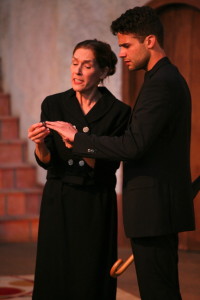
Jessica Powell as The Countess of Rousillion and Adam Magill as her son, Bertram. Photo by Eric Chazankin.
The tall, angular Magill also bears a striking resemblance to the stunning Jessica Powell who plays his mother. She has been a stalwart of the summer, playing roles in all three productions, but it is here that she really shines as the loving, but torn, Countess. Her strong-willed gravity lends Magill’s Bertram extra integrity, even when they find themselves at odds. He seems very much her son.
Exceptional Ensemble
Although often thought of a large show, Marin has edited it so that it is performed by just nine actors. The cast is without a weak link. Scott Coopwood is a charismatic Lafeu, the nobleman who is the closest thing to a father figure to both Bertram and Helen. He also effortlessly absorbs lines and functions traditionally performed by minor characters, allowing the cast to be streamlined.
James Hiser is very funny as the braggart soldier, Parolles, whose cowardice may account not only for his absence from battle but his otherwise unexplainable hostility to sex. (He counsels Bertram to flee his marriage bed, and is later discovered to have intended to subvert an assignation Bertram pursues with a local girl, Diana.) It is when the character is hoodwinked by his fellow soldiers and his cowardice laid bare that Hiser is best. Parolles’ realization that he has lost his honor, but has to live with his disgrace forever, was heartbreaking.
Speaking of that local girl, Diana, – the character was superbly played by Luisa Fransconi, who was so delightful in Livermore Shakespeare’s The Liar earlier in the summer. Heather Cherry played her bombshell mother with equal zest.
Jack Powell played the King of France broadly, literally doing a jig when cured of his illness. He became most believable and affecting late in the play when he was paired with his real life wife, Jessica – playing the Countess – trying to sort out the confusions of the script.
1962?
The production was set in 1962, which I began thinking didn’t really work and came to believe didn’t really matter – except in the case of the clown, Lavatch, played by Lucas McClure. Lavatch is very much in the mold of Twelfth Night‘s Feste, only lascivious. The only thing seemingly grounded in the real world of 1962 was McClure’s wonderful portrayal of Lavatch as a second-rate folk singer. He was hilarious as a combination jester/doorman who was tripping ahead to the summer of love half a decade before anybody else.
Marin uses a single unit set by Shannon Walsh for all three productions, and it is probably too much to ask that it work equally well as a Spanish Castle for the Spanish Tragedy, a Southwestern town for the adaptation of Comedy of Errors set in west Texas, and as Paris, Florence, and Rousillion in this show. The truth is, for this show it doesn’t work. The Rothko and Mondrian hanging on the Mission-style walls just seemed ridiculous. Eventually, however, one settles into the play by treating the background as neutral. It is certainly no weirder than the Tudor-style Elizabethan playhouse of Shakespeare’s time, the reality of which one was to ignore.
The lack of realistic specificity about 1962 did not harm the performance much, however, because its timeless folktale nature must be brought to the fore anyway. That, Currier did brilliantly, especially in the wonderful moment in which the King is cured, ironically accompanied by Moog music and pre-disco lighting effects.
The program and a pre-show talk hinted as a surprise ending, but what emerged was actually an extremely logical non-ending. All may be well that ends well, but in this case we don’t really know what will happen after the curtain falls. We are left to imagine the speed of Bertram’s maturing, and the depth of his repentance, and maybe even the sincerity of his appreciation for Helen. Currier’s Lady-or-the-Tiger finish felt neither like a surprise nor a cop-out, but an entirely Shakespearean moment in which we must piece out their imperfections with our minds.
Review: A COMEDY OF ERRORS (sic) at Marin Shakespeare Company
September 5, 2013 § Leave a Comment
Not “The,” But Certainly “A,” Comedy of Errors
The Marin Shakespeare Company’s country-western version of Comedy of Errors, adapted and directed by Lesley Schisgall Currier and Robert Currier and set in “old-timey” Texas, is silly and slight, but despite it coming from a very different place than is my usual taste it was nonetheless filled with enough delights to keep me entertained and intrigued.
The Comedy of Errors is an outlier among Shakespeare’s comedies. Although “city” comedies were a popular genre in his time, this is Shakespeare’s one and only play in this less-character-driven style. Errors is an adaptation of a play by the ancient Roman playwright Plautus. It is thought by many – including Marin Shakespeare Company’s Artistic Director Robert Currier – to be his earliest work. The widespread, but imho teleological, argument is that “early” equals “not very good.” The play is often performed, fast and loose, with plenty of buttressing. (In the late ’80s, in a version easily accessible online, The Flying Karamazov Brothers performed it as an extended juggling act.)
While disagreeing that the play lacks substance, even those of us that find hidden depth in the text accede that it is, fundamentally, a farce of mistaken identity. While I missed a serious exploration of family loss and reconciliation (“Ugh,” I can hear the directors say, “go watch Pericles!”), from the perspective of pure performance there is lots to see and discuss.
It Happened Like This…
The plot concerns a scattered family. Long ago, parents Aegeon and Aemilia suffered a shipwreck from which each managed to save an identical twin son and that son’s servant, “coincidentally” also a twin, but were parted from each other. Separately, they each managed to see their charges raised to adulthood, without ever knowing the fates of their lost spouses and children.
Years later, Aegeon (of Syracuse in the play, but Amarillo in this version), is traveling around the Mediterranean (Texas) in search of his long lost wife and her charges, and also his own son and servant who had set out on a similar mission years earlier and never returned. He arrives in Ephesus (Abilene) only to find that the cities are at odds, and he is arrested and sentenced to hang at the end of the day if he cannot find someone who will pay his surety.
Unbeknownst to him, his son and his servant have also arrived in town, but have hidden their origins, and move about unhindered. Unbeknownst to them, both the son’s and servant’s lost identical twins are living and prospering in this city. The “errors” of the play are the constant mistaking of the visiting twin for his resident brother, resulting in the visitor being showered with gifts, praise and even a romantic encounter with his “wife,” (although his heart belongs to the unmarried sister-in-law) while his bewildered brother is systematically denied his money, his home and even his identity. Meanwhile the twin servants are constantly encountering the wrong master. Beatings ensue. In the end, a local abbess manages to sort everything out by finally bringing all the family members on stage at once, and providing a surprise twist of her own. No spoiler: if you don’t know how it ends, go see it!
Twins, Twins
In performance, the most interesting question is how to handle the two sets of identical twins – given that finding even one set of talented twin thespians is not an easy task. Most productions do the next best thing – which is to cast similar looking actors and dress them in nearly identical twin costumes, although usually in some color-coded variation to help us sort them. An interesting variation, perfectly in the spirit of farce, is to cast actors who look absolutely nothing like each other and then dress them alike. I’ve seen a hysterically funny performance in which one of the twin servant Dromios was played by a short, rotund, African-American woman and the other by a tall, thin, almost freakishly white dude. The ease with which we, as audience, could tell them apart rendered even funnier the convention by which the onstage characters could not.
Of course, the premise of the plot requires that the twins are never onstage together until the final scene, so a common solution – and the one adopted by Marin – is to cast just one actor to play the twins using the similar-looking doubles only when it finally becomes necessary.
(Okay, there is one earlier scene in which both Dromios are heard, but one is inside a house of which the other is locked out, so usually only one is visible. By far the funniest sight gag of the evening in Marin was that the interior Dromio – played by the uncredited double – was visible through a window, or would have been had he not been holding an increasingly implausible series of tall props that blocked his face. At first he seemed like an inexperienced actor who didn’t quite realize how large the bottle on the tray he was holding was, but by the time he lugged on a life-sized bust of Shakespeare, the joke was clearly intentional.)
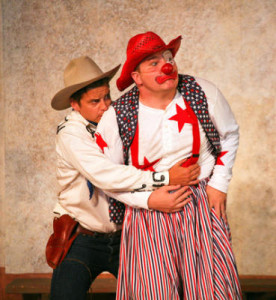
Patrick Russell as Antipholus and Jon Deline as Dromio in Marin Shakespeare Company’s ‘A Comedy of Errors.’ Provided by Eric Chazankin
Star Power
Adopting the single actor solution requires bravura performances. Marin gets them, and then some, from Jon Deline as the Dromios and Patrick Russell as the Antipholi. Literalizing the designation of the Comedians as “Clowns” in Shakespeare’s texts, Deline was costumed (by designer Tammy Berlin) as a rodeo clown with full make-up and fake nose. He is a gifted physical comedian and his best bits were running gags, especially the beatings he took at the hands of his masters. Supplying both grunts and slapping sound effects himself, he managed to alleviate any sense of real harm, while deftly parodying stage combat conventions, by extending the series long beyond the point that his fellow actors mimed contact. The text was so loosely adapted during the entire show, that it made little difference when Deline departed from it, which he did with frequency and relish.
Russell tackled the far more difficult challenge of the Antipholi with astonishing skill. As the visiting Syracuse, he embodied the fresh-faced protagonist perfectly, with growing astonishment as his every wish is granted before it is even spoken, and without any responsibility for his actions. He also captured the loneliness of the character who seemed to be less searching for his missing twin, than trying to find himself. As the smugly privileged brother in Ephesus, his demeanor – not to mention his mounting frustration as his world fell apart – was physicalized so distinctly that it took me a couple of scenes to be certain that the twin performances were being handled by a single actor. When Ephesus finally broke down in what can only be described as a “hissy-fit,” I fell out laughing at his inventiveness.
Bravely, Marin did not color-code the performers in the show. Reappearing in unchanging costumes, they left it to the actors to make clear what is happening. I never had a moment of doubt, however, which Antipholus I was seeing.
Virtuosity
Other kinds of virtuosity were on display in the show, from a cast that doubled as the onstage band, to an extensive display of vocal talent from numerous performers belting out both country-western standards and original songs by Leslie Harlib. Women are generally given short shrift in this play, so Amanda Salazar as Adriana and Elena Wright as Luciana made the most of their opportunities for musical expansion. Shirley Smallwood stopped the show with one great ballad incorporated into her tiny part as the Courtesan. The inserted music was not always well-integrated, and often only a line or two or a famous song was quoted as commentary, but the performances were still impressive. (I’m convinced that the Amarillo was selected as the substitute for Syracuse solely so that Russell could sing “Amarillo by Morning.”) The original songs, however, were more cohesive. Musically they were cw simplistic, but the lyrics were exceptionally clever.
Gary Grossman delivered the most irreverently funny performance of the evening as Dr. Pinch, a crackpot imported to cure the “madness” of Antipholus of Ephesus. Dr. Pinch was portrayed as an Indian Medicine Man, of the most horrendous stereotypical style possible, complete with “How”s and “Ug”s. It might have been unendurably offensive if intended as anything like a real comment on Native Americans, but Grossman performed it all in the broadest Borscht Belt style (and dialect) possible. His chants of “Hey, yu, yu, yu”s had a way of morphing into “Hava Nagila.” In under five minutes he managed to pillory everything from psychoanalysis to the nonsensical premise of the show in the Wild West.
You gotta laugh at a production that can laugh at itself.
Review: THE SPANISH TRAGEDY at the Marin Shakespeare Company
July 25, 2013 § Leave a Comment
A 425 Year-Old Debutante
For fans of Shakespeare and his contemporaries, the warmth of summer brings in the feasting season. Dessert this year is the Marin Shakespeare Company’s production of the rarely performed Thomas Kyd masterpiece, The Spanish Tragedy. (In fact, after 425 years it is said to be making its Northern California debut.)

Hieronimo, Knight-Marshal of Spain (Julian Lopez-Morillas) mourns for his murdered son Horatio (Erik Johnson) in Marin Shakespeare Company’s outdoor production of Thomas Kyd’s “The Spanish Tragedy.”
Photo by Eric Chazankin
The plot of Kyd’s revenge tragedy has more than a passing resemblance to Hamlet, a comparison from which it usually suffers but which also supplies it endless fascination. Although its date of composition is uncertain most scholars place it in the mid-to-late 1580s at just about the same time Shakespeare was probably starting his career in London. It is some dozen years older than Shakespeare’s Hamlet, a model therefore, and not a copy.
Spanish Tragedy opens with a ghost seeking revenge – accompanied in the play by a character named Revenge, in fact. It also features a doubting and delaying revenger who feigns madness to buy time, a woman driven genuinely mad by loss who eventually commits suicide, and a decisive play-within-a-play. Solely on the evidence of this resemblance, in fact, Kyd is believed to be the author of the mysterious ur-Hamlet, the now lost play on which Shakespeare is thought to have based his version.
The misfortune of the Spanish Tragedy is that through most of the twentieth century it was usually studied not because it is the progenitor of the revenge tragedies that dominated the Elizabethan stage, although it is, but as a less subtle comparator to Hamlet, useful for teleological arguments “proving” Shakespeare’s genius. Theater companies have had little incentive to produce it because the inevitable criticism is that it is nothing but a sensational oddity from the dustbins of history.
Body Counts and Comparisons
Among the things that becomes clear from watching the play in performance in Marin (from an edition prepared by the company’s skillful dramaturg, Mary Ann Koory) is that Hamlet is the wrong comparator. It is far more like Shakespeare’s first – and decidedly unsubtle – revenge tragedy, Titus Andronicus. It has a plotting Iago-ish Machiavellian character at its center, like Titus’ Aaron. The revenger is not a son, but a father, like Titus. A powerful woman drives the plot forward, like Tamora. Most of all, it is not structured around introspective monologues, but (exactly like Titus) around grisly and horrific violence – lots and lots of violence. If you are not familiar with Titus, the Royal Shakespeare Company has prepared a helpful graphic of the body count for its current production, attached here.
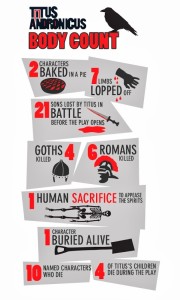
The Royal Shakespeare’s infographic of the Titus body count, to which Spanish Tragedy is a worthy rival.
Similarly, The Spanish Tragedy begins with a murdered minor nobleman, Don Andrea, tallying the deaths from a war in which, by the rules of chivalry, he would have been taken prisoner for ransom instead of killed. It proceeds through the onstage murder of a bound victim, two ambushes of unsuspecting co-conspirators to eliminate witnesses, a narrowly averted burning at the stake of an innocent man, an unexpected hanging of a guilty one who thought he had bribed his way to freedom, an offstage suicide, a final scene with so many deaths that it leaves the lines of succession of both Spain and Portugal destroyed, and the hero biting out his own tongue so he cannot be forced to confess!
Before “To be, or not to be” there was “Oh eyes, no eyes”
Titus, of course, was not held in high esteem until very recently, when it began to be judged by its own Senecan aesthetic aims instead of belittled for not being more like the late tragedies. Ironically, it was Shakespeare’s most successful play in his lifetime. It did not hold a candle to Spanish Tragedy, however, which was the most successful play of the entire period. It has more recorded performances and more references in plays, poems, and diaries than any play before the Commonwealth. What “To be or not to be” is to us now, the protagonist, Hieronimo’s, great speech “Oh eyes, no eyes, but fountains fraught with tears” was to the early modern audience then.
Julian Lopez-Morillas plays Hieronimo with a riveting intensity throughout, but his delivery of the famous monologue confirmed its still current fascination, as he used it to shift the action into a higher gear. His dark humor and grisly determination had the same kind of power that Antony Hopkins brought to Julia Taymor’s filmed Titus. In his hands we begin to see what all the fuss was about.
Few in the cast could keep pace with him, but Elena Wright was an intriguing (in both senses of the word) Bellimperia, the female lead around whom much of the plot turns. Female characters from the period generally do not have the agency and intensity that Bellimperia has, and Wright reveled in the chance to play her strength. Erik Johnson was a very charismatic Horatio, the young man in love with her, and the presumed revenger, until he is captured and casually murdered in front of her (and us) midway through the play. Scott Coopwood played Bellimperia’s father, a particularly complex role, notably.
It is carping to note that much of the rest of the very large cast was less experienced, since the economic reality is that is about the only way any company could afford to mount this show. The divide between the professionals and the others was wide, however, and both the pace and the verse speaking suffered often because of it. The production’s strengths were heavily invested in the protagonists, unbalancing the action when the antagonists were (at least theatrically) not their match. A surprising set of comic characters who seem to have wandered into the tragedy from Much Ado, however, helped to energize the second half.
Beautiful Executions
Set Designer Shannon Walsh created a beautiful and varied Spanish compound, but for some reason chose not to structure any visual relationship between the three sets of gallows for major executions that sub-divide the play into acts – often thought of as the main visual motif of the play. Costume Designer Abra Berman gave us authentic period appearances for the characters, especially effective in visually aiding the audience to keep track of the complex alliances and shifting locales.

The murder of Hieronomo’s only son, Horatio (played by Erik Johnson, pictured), sets off a chain of murderous events in Marin Shakespeare Company’s outdoor production of “The Spanish Tragedy.”
Photo by Eric Chazankin
“Where Words Prevail Not, Violence Prevails”
Only in the final moments of the play did the production completely rise to the occasion, bring home to message encapsulated by its most famous line. When it blossomed into its full potential, however, it was easy to see why the vicarious power fantasy of revenge, and the sensational violence, was as popular as it was. In much the way that Titus has been rehabilitated in the last half century after nearly three hundred years of dormancy, The Spanish Tragedy seems ripe for rediscovery. The combination of black humor and suppressed rage at state sponsored (or at least tolerated) injustice – of which poor Kyd as a victim when he was tortured and his health permanently destroyed as collateral damage in the campaign to ensnare Christopher Marlowe – was not a Victorian taste, but seems all too apropos these days. We can only thank and admire Marin Shakespeare Company for exploring this gem.
